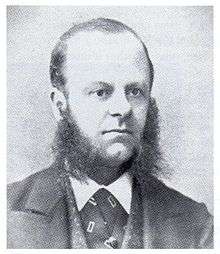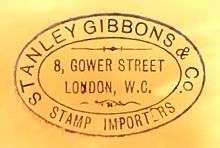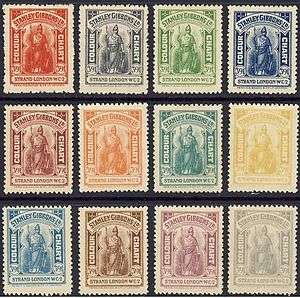Stanley Gibbons
 | |
| Public (AIM) | |
| Traded as | LSE: SGI |
| Industry | Specialist retailing |
| Founded | 1856 |
| Headquarters | Jersey, Ringwood & London. |
Key people | Michael Hall - Chief Executive |
| Website | www.stanleygibbons.com |

The Stanley Gibbons Group plc is a company quoted on the Alternative Investment Market (AIM) of the London Stock Exchange and which specialises in the retailing of collectable postage stamps and similar products.[1] The group is incorporated in Jersey but with offices in London, Ringwood in Hampshire and Guernsey. They have also recently opened new offices in Hong Kong and Singapore. The company is a major stamp dealer and philatelic publisher. The company's philatelic subsidiary, Stanley Gibbons Limited, has a royal warrant of appointment from Queen Elizabeth II.
History of the company

The company has a long corporate history, having started as a sole trader business owned by Edward Stanley Gibbons in 1856 and now being a quoted company with a number of subsidiaries.
Before 1900
The business started when, employed as an assistant in his father's pharmacy shop in Plymouth, Gibbons set up a counter selling stamps.[2] In 1863 he was fortunate enough to purchase from two sailors a sackful of rare Cape of Good Hope triangular stamps.[2]
In 1874 Gibbons moved to a house near Clapham Common in South London and in 1876 he moved again to Gower Street in Bloomsbury near the British Museum.
By 1890 Stanley Gibbons wished to retire and the business was sold to Charles Phillips for £25,000 (equivalent to £15.2 million in 2010).[3] Phillips became Managing Director, with Gibbons as Chairman.[2]
In 1891 a shop was opened at 435 Strand in addition to the Gower Street premises, and in 1893 the shop and offices were amalgamated at 391 The Strand where the company's retail premises remained for many years until they moved to 399 The Strand.

1900–1959
A new issue department was opened in 1906.
In 1914 the company received a royal warrant from George V.[2]
In 1956 the company celebrated its centenary with an exhibition at the Waldorf Hotel opened by Sir John Wilson. It is in that year that Queen Elizabeth II granted her royal warrant to Stanley Gibbons Ltd as her philatelist.[4]
1960s
In 1967 the firm expanded into the United States in a joint venture with Whitman Publishing. A magazine and catalogues were produced.
In 1968 the previously privately held Stanley Gibbons Limited was floated on the stock market through a tender arranged by S.G. Warburg & Co. Ltd. The offer was a huge success and was oversubscribed five times. The shares were sold at 20 shillings rather than the minimum tender price of 12 shillings and six pence.[5] It was estimated that there were 30 to 35 sharesholders before the offer and they still owned 66% of the equity after the offer, worth at least £1.8 million before trading began.[6] Prices subsequently slipped back, however, later in the year.
1970s
In 1970 The Crown Agents acquired a 20% stake in the company and appointed two Directors to the Gibbons board.[7] The stake was sold in 1976 by which time it had grown to 25% of the company.
In 1977 Stanley Gibbons acquired the stock of the firm Chas Nissen, once run by the eminent stamp dealer and philatelist Charles Nissen.
In 1979 Gibbons was bought by Letraset for £19 million in an attempt to diversify away from their dry-lettering business, but the acquisition did not go smoothly and like Flying Flowers later, Letraset faced difficulties integrating Gibbons into its core business.[8] The Chairman of Letraset blamed "indiscriminate expansion" and "imprudent" investment decisions for the problems at Gibbons and was quoted in The Times as saying "We significantly overpaid for what we got."[9] The US$10 million paid by Gibbons for the Marc Haas collection was also questioned.
1980s
In 1981 Letraset was taken over by Esselte after Esselte fought a takeover battle with Mills & Allen International for the company. Letraset had been fatally weakened by losses sustained in its Stanley Gibbons subsidiary. Later the same year Gibbons was put up for sale by Esselte as they said it did not form a logical part of their long-term development.[10]
In 1981 Gibbons bought the stock of the late H.F. Johnson.
In 1982 Clive Feigenbaum staged a management buy-out followed by an application in 1984 for a listing on the UK's Unlisted Securities Market in order to raise funds for new acquisitions. Following the buy-out, Feigenbaum, the Chairman, had owned over 50% of the shares with the others owned by the rest of the board.[11] The listing went ahead but the shares were suspended within moments of their debut even before trading had begun, following concerns about Feigenbaum's background highlighted in an article in the Sunday Times. The suspension was said to be the fastest on record at that time. The concerns had surrounded Feignebaum's expulsion from the Philatelic Traders Society for breaching their code of ethics and his sale of "23 carat gold" stamps of no postal validity from the island of Staffa. U.S. government tests had shown the stamps, sold at £10 each, to have a gold value of about 5c each. The debacle was said to have caused considerable embarrassment, not just to the company but also to its USM brokers Simon & Coates.[12] Shortly afterwards, Feigenbaum resigned as Chairman and was bought out by a consortium of institutions and individuals for £3 million.[13] A further attempt at a listing was planned for 1985 but did not go ahead.
In 1989 Paul Fraser began to invest in the firm, and he purchased a further 30% stake in the company from New Zealand businessman Sir Ron Brierley who is a stamp collector.[14]
1990s
Paul Fraser was appointed Executive Chairman in 1990.[15] By 1995 Fraser had acquired 76.83% of Gibbons shares and he purchased the rest of the shares in December 1995.[16]
In June 1998 the company was sold for £13.5 million to Flying Flowers. Paul Fraser took shares in Flying Flowers instead of cash and was left with an 8% stake in the enlarged company following the deal.[17] The merger was not a success and in 2000 the two companies were demerged again after a series of profits warnings and trading problems. Paul Fraser's stake was reduced in value from £13.5 million to £4 million. The de-merged Stanley Gibbons became Communitie.com and was listed on AIM. The chairman of Flying Flowers was quoted as saying the deal "...was at the wrong price and at the wrong time."[18][19]
Since 2000
In August 2007, Paul Fraser resigned as Executive Chairman[20] and in April 2008 he sold his remaining shares to focus on Paul Fraser Collectibles.[15] Bob Henkhuzens became Interim Chairman and the current Chairman is David Bralsford who works in a non-executive capacity. The company is currently led by Mike Hall as Chief Executive.[21]
On 20 September 2010 the company announced it had acquired the trade and assets of the Benham first day cover and collectibles business from Flying Brands Limited. On 31 October 2012 the company announced its acquisition of the online collectibles trading platform, Stampwants.com Inc, trading as bidStart.[22] One year after the acquisition of bidStart, on 21 November 2013, Stanley Gibbons successfully completed its acquisition of Noble Investments, bringing Apex, Baldwin's, and Dreweatts & Bloomsbury Auctions into the group.[23] In 2014, two further acquisitions followed: On 31 January the company acquired Murray Payne, the world’s leading dealer in British Commonwealth King George VI stamps [24] and on 23 October The Fine Art Auction Group, holding company of the Group's subsidiary, Dreweatts and Bloomsbury, announced that it had acquired Mallett Antiques - a world-renowned dealer in the finest antiques and decorative arts with retail premises on London's Dover St and New York's Madison Avenue.[25]
On 28 January 2015 the company was awarded 'Deal of the Year' at the 2015 Quoted Company Awards for its acquisition of Noble Investments.[26]
In July 2015 the company announced that The Fine Art Auction Group had acquired Bid for Wine, a specialist online wine auctioneer founded in 2008 by barrister Spenser Hilliard and ex-management consultant Lionel Nierop.[27][28]
Stamp catalogues

The first Stanley Gibbons stamp catalogue was a penny price list issued in November 1865 and reissued at monthly intervals for the next 14 years.[29] The company produces numerous catalogues covering different countries, regions and specialisms; many of them are reissued annually. The catalogues list all known adhesive postage stamp issues and include prices for used and unused stamps.
Unlike other dealers' catalogues, Stanley Gibbons state that their catalogue is a retail price list. In other words, if they had that exact stamp in stock in the exact condition specified, the current catalogue price is the price that they would charge for it. This contrasts with most other catalogues which are produced by firms that do not sell stamps and therefore base their pricing on an average of market values in the country where the catalogue is published.
In practice, the actual price charged by Stanley Gibbons for an individual stamp may be different from the catalogue price because the specimen for sale is of a different grade, the market conditions have changed since the catalogue was produced, the firm has a plentiful or restricted supply of that stamp, or for a variety of other reasons.
Magazines

Gibbons Stamp Monthly is a magazine that lists new issues and publishes articles of interest to philatelists. Gibbons have published a number of journals over the years but only settled on Gibbons Stamp Monthly as their core magazine in 1927.[30] On 23 January 2009, Gibbons acquired the philatelic trade magazine The Philatelic Exporter from Heritage Studios Limited.[31]
Retail stamp business
As well as publishing, Stanley Gibbons is a stamp dealer with a retail business located on the Strand in their Central London offices offering both older stamps and new issues and fulfilling customer want lists. They produce their own line of other philatelic products, such as albums, stock books, and other accessories.
Auction house
The company is also a philatelic auction house and has held thousands of international sales since it was established in 1901.
Investment department
Since around 2000 the company has actively offered stamps as investments and has set up a special office in Guernsey for this activity.[32] The company had offered a similar service in the early 1970s on a small scale. Sales of investment products have been strong in Asia and the Middle East and through the company's email database, however, sales in the United Kingdom have been hampered by the fact that the company's philatelic investment products are not regulated by the UK Financial Services Authority and therefore UK financial institutions and financial advisers have been reluctant to recommend the products as investors would not enjoy the same level of protection they receive when investing in regulated products. Gibbons have stated that they intend to launch a regulated investment fund in order to overcome this obstacle.[33]
As recently as 2002 the company's attitude to philatelic investment was that stamps were purely a hobby. Many in the stamp business still had unpleasant memories of the excesses of the 1970s bubble.[34]
Some financial advisers and stamp dealers have doubted the wisdom of investing in stamps due to the relatively high prices charged by Stanley Gibbons compared to other dealers and the experience of the 1970s when many investors lost out after a speculative bubble in stamps burst.[35] The relatively high initial costs have also provoked comment, estimated at not less than 20% compared with less than 5% for many retail mutual fund type investments. Gibbons have responded by emphasising the high quality of their items and the long-term nature of their investment proposition.
In 2007 financial news website Bloomberg announced it would publish the SG100 Stamp Price Index, an index based upon retail and auction prices for the top 100 most frequently traded stamps in the world.[36]
In 2008 a complaint was made to the UK Advertising Standards Authority that the guarantees offered by Gibbons in the advertising for their investment products could not be substantiated. After investigation the complaint was not upheld, as no portfolios had yet reached their maturity.[37]
Other businesses
The Group's subsidiaries include autograph dealer, Fraser's Autographs, Benham first day cover and collectibles business, online collectibles trading platform, bidStart [21]; Apex Philatelics, Baldwin's Coins, Dreweatts & Bloomsbury Auctions [22], Murray Payne, wine auctioneer Bid for Wine[38] and Mallett Antiques.
Financial information
The company's accounting year ends on 31 December and in the year ended 31 December 2009 it had total sales of over £23.4 million and a profit before tax of over £4.1 million.[39]
See also
References
- ↑ "Company Details". Stanley Gibbons. Retrieved 2009-09-26.
- 1 2 3 4 "The Story of Stanley Gibbons" by Michael Briggs in Gibbons Stamp Monthly, July 2006, pp.52–59.Download link
- ↑ United Kingdom nominal Gross Domestic Product per capita figures follow the Measuring Worth series supplied in Lawrence H. Officer (2011), "What Was the U.K. GDP Then?" MeasuringWorth. These figures represent the figures prior to the update to the Blue Book in October 2011.
- ↑ Tyzack, Anna (2012-05-21). "Royal Warrant holders: the seal of approval". The Daily Telegraph. London.
- ↑ "S Gibbons struck at 20S" by John Gilmore in The Times, 6 April 1968, p.12.
- ↑ "Paying for Gibbons scarcity value" by John Gilmore in The Times, 8 April 1968, p.24.
- ↑ "Crown Agents take Gibbons stake" in The Times, Bids, Deals & Mergers, 4 September 1970, p.26.
- ↑ "Coming Unstuck in Stamps" by The Financial Editor, The Times, 13 August 1980, p.17.
- ↑ "Stamp of success eludes Letraset" by Peter-Wilson Smith in The Times, 17 January 1981, p.19.
- ↑ "Stamp firm Gibbons back on sale" by Paul Maidment in The Times, 8 December 1981, p.15.
- ↑ "Stanley Gibbons to join market" by Michael Clark in The Times, 26 March 1984, p.19.
- ↑ "Stanley Gibbons suspended within moments of debut" by Michael Horsnell & Jonathan Clare in The Times, 3 April 1984, p.21.
- ↑ "Stanley Gibbons stake nets £3m" by Jonathan Clare in The Times, 1 May 1984, p.17.
- ↑ Cope, Nigel (2002-10-21). "A serious collector in tune with the times". London: The Independent. Retrieved 2010-09-29.
- 1 2 "Our Expert Panel". Paul Fraser Collectibles. 2010-03-29. Retrieved 2010-09-29.
- ↑ Briggs, Michael (July 2006). "The Story of Stanley Gibbons" (PDF): 52-29. Retrieved 2010-09-29.
- ↑ Cope, Nigel (1998-04-08). "Owner sells Stanley Gibbons for pounds 13.5m". London: The Independent. Retrieved 2010-09-29.
- ↑ Cope, Nigel (2000-03-29). "Flowers to demerge Stanley Gibbons". London: The Independent. Retrieved 2010-09-29.
- ↑ O'Sullivan, Jack (1999-03-24). "The stamp collector who lost a mint in the flower market". London: The Independent. Retrieved 2010-09-29.
- ↑ "Retrieved 10 March 2010". Webcitation.org. Archived from the original on March 10, 2010. Retrieved 2010-09-29.
- ↑ "Stanley Gibbons: Our Directors 3 November 2011 archived at WebCite". Webcitation.org. Archived from the original on March 11, 2010. Retrieved 2010-09-29.
- ↑ http://www.stanleygibbons.com/images/sg/documents/SG_Acquisition_31_10_12.pdf
- ↑ http://www.stanleygibbons.com/images/sg/corporate/Noble_2013_11_21.pdf
- ↑ http://www.stanleygibbons.com/images/sg/corporate/PR-%20MP%20acquisition-v1.pdf
- ↑ http://www.stanleygibbons.com/images/sg/corporate/Mallett_Antiques_acquired_by_Dreweatts_and_Bloomsbury.pdf
- ↑ http://www.antiquestradegazette.com/news/2015/feb/09/stanley-gibbons-group-wins-deal-of-the-year-award-for-noble-acquisition/
- ↑ http://www.harpers.co.uk/news/stanley-gibbons-buys-bid-for-wine-online-auction-platform/521862.article
- ↑ http://www.thedrinksbusiness.com/2010/02/fine-wine-profile-bid-for-wine/
- ↑ Phillips, Stanley. Stamp Collecting: A guide to modern philately, revised edition, Stanley Gibbons, London, 1983, p.244. ISBN 0-85259-047-4.
- ↑ "75 Years of Gibbons Stamp Monthly" by Michael Briggs in Gibbons Stamp Monthly, October 2002, pp.77–81.
- ↑ Stanley Gibbons acquires Philatelic Exporter philatelicexporter.com, February 2009. Retrieved 23 April 2014 from Internet Archive.
- ↑ "Stanley Gibbons Investments". Stanley Gibbons. Retrieved 2009-09-26.
- ↑ "Chairman's Statement" (PDF). Audited Results for the year ended 31 December 2008. Stanley Gibbons. 2009-03-20. Retrieved 2009-09-26.
- ↑ Levene, Tony (2002-06-15). "Stamps are easily licked". London: The Guardian. Retrieved 2010-09-29.
- ↑ Levene, Tony (2005-01-22). "Philately won't get you anywhere". London: Guardian. Retrieved 2010-09-29.
- ↑ Litterick, David (2007-10-12). "Bloomberg puts stamp on Stanley Gibbons indices". The Daily Telegraph. London.
- ↑ "ASA Adjudication on Stanley Gibbons (Guernsey) Ltd". Advertising Standards Authority. 2008-04-30. Retrieved 2010-09-29.
- ↑ http://www.antiquestradegazette.com/news/2015/jul/16/stanley-gibbons-buy-online-wine-auctioneer/
- ↑ "Stanley Gibbons Group Ltd. Audited Results for the year ended 31 December 2009." (PDF). 2009-03-20. Retrieved 2010-09-29.
External links
| Wikimedia Commons has media related to Stanley Gibbons. |